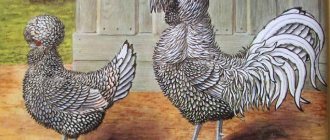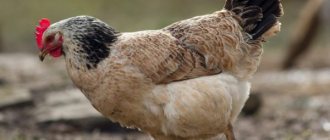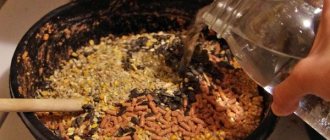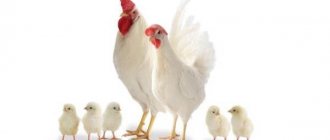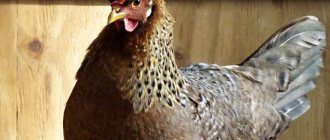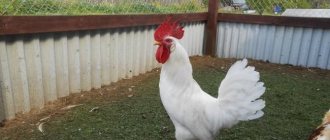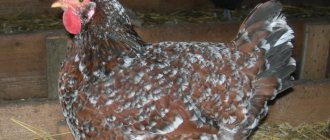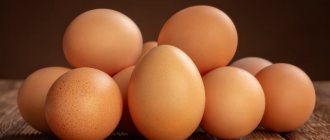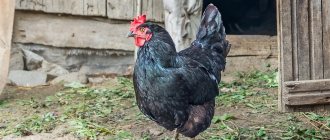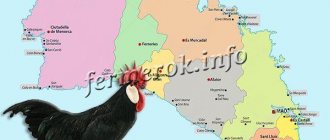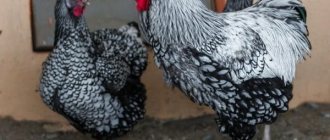Description of the breed
Vorwerk chickens are not only highly productive, this variety will be a wonderful decoration for any poultry yard due to its colors. The head of the chickens is black, the chest, belly and dorsal parts are covered with golden-red plumage. And due to the clear boundary separating the colors, this variety can be seen in any poultry yard.
Important: If you want to start breeding this breed, please note that purebred chickens should not have light-colored paws or uncolored earlobes.
According to the description, the forwerk is endowed with the following characteristics:
- the figure has standard dimensions;
- the body is squat, round in shape;
- the chest and abdomen have a massive shape;
- the lobes and comb are painted bright red, which makes them stand out in contrast against the background of the black head;
- the live weight of an adult male reaches 4-4.5 kg, and that of a chicken 3-3.5 kg.
The character of this breed is friendly and non-conflicting. Not only adults, but also children will find a common language with this breed.
Breeding large Forwerks and bantam versions
The Vorwerk was registered as a breed in 1913. To remove it the following were used:
- Lakenfelder;
- Orpington;
- Sussex;
- Andalusian.
Vorwerk inherited specific color zones from Lakenfelder and Sussex.
The following people took part in the appearance of the miniature copy:
- Lakenfelder;
- red and blue Wyandottes;
- Colombian blacktails;
- Rosecombe.
The latter are true bantams.
Interesting! The standard version of the Vorwerk has never been recognized by the American Association, while the American version of the Vorwerk bantam is recognized by European organizations.
But since European fanciers miniaturized Vorwerks independently and independently of America, using other breeds, the standards of bantams are different.
Rules for keeping and caring for the breed
Despite the fact that the homeland of the forwers is Europe, this variety has taken root well in our latitudes.
Moreover, chickens are not considered fussy and are adapted to low temperatures. At the same time, the poultry farmer will still need to create some conditions for the normal development of chickens:
- Forwers love to forage, which is why it is recommended to plant clover or alfalfa in the paddock where the birds will walk;
- If there are other breeds of chickens living in the owner’s yard, it is advisable to protect their access. The reason is that this species lacks aggression, which cannot be said about other birds;
- for chickens you will need to set up a brooder; cover the floor with sawdust, hay or peat. Such flooring in the pen is changed 2 times a year, with the onset of spring and before cold weather;
- consider good ventilation to prevent the occurrence and spread of infections;
- If possible, make windows in the chicken coop, they will help increase daylight hours, which will have a positive effect on egg production;
- when planting chickens in a poultry house, try to ensure that per 1 sq. there were no more than 5 laying hens per meter;
- The optimal height of the chicken coop is 2 meters. It is easier to heat such a room in winter;
- When laying the floor, make it smooth. This will make disinfection and cleaning easier. In addition, when choosing a flooring material, give preference to adobe or wooden flooring;
- in the cold season, the optimal temperature for adults is +8 °C; with the onset of warm weather, it is recommended to keep the temperature at +21 °C. To make such a task feasible in extreme heat, place the chicken coop between the trees and coat the outside with clay;
- If the number of hens is small, secure perches around the perimeter of the brooder. The optimal dimensions for one perch will be 20 cm wide and 90 cm high. If there are a lot of chickens, multi-tiered perches are made;
- make or purchase boxes for nests, 30 cm wide. Cover them with straw or hay and place them around the entire perimeter of the chicken coop;
- Before placing young birds in a brooder for adult birds, disinfect them. Clean the chicken coop, ventilate and treat the walls, ceiling, and floor with slaked lime.
After planting the young animals in the brooder, keep it clean. Remember, a dirty chicken coop is an ideal place for dangerous infections to appear and spread.
Puberty and oviposition
Vorwerk chickens, the description of the breed says that they mature at an average rate. The approximate age of onset of egg laying for laying hens is 6 months. But, with the beginning of egg laying, the growth phase does not end - both laying hens and roosters continue to gain weight throughout the entire first year of life, and sometimes a little longer.
Egg production rates are also average. Winged Germans lay small eggs with a yellowish shell. Their weight ranges from 50-55 grams, but only the largest are selected for offspring.
Peak productivity in chickens occurs in the first year after reaching maturity. During this period, laying hens are able to produce about 170 eggs, and in subsequent years one can observe a rapid decline in these indicators.
Choosing an area for a walking yard
The ideal location for bird walking is considered to be the south side. At the same time, you need to remember the safety of the forework. Therefore, it is recommended to stretch the mesh up to 2 meters high. The fact is that despite the large weight of this breed, they fly excellently. When setting up a walk, adhere to the following rules:
- the area of the poultry yard should be twice as large as the chicken coop;
- It is recommended to connect the brooder and the walking yard with a small manhole with two doors. Some doors are mounted on the inside, and others 10 cm higher, from the floor;
- in winter, you need to regularly clear the hole of snow, and with the onset of warmth, install a canopy to create shade.
As mentioned above, the walking yard is sown with grass. This will allow the birds to forage, which means that food consumption in the warm season will decrease.
Diet of adult chickens
Specifics of seasonal feeding
During the warmer months (spring and summer), feed your flock of chickens twice a day, morning and evening. The chickens will dine on their own while walking.
In winter and autumn, feed the birds three times a day, and add nettle or pine flour and vegetables to the diet.
It is also advisable to dry plants that are useful for chickens for the winter: tops of root vegetables (beets and carrots), dandelions (foliage) and nettles.
Prohibited "products"
When collecting greens, check that the picked grass does not accidentally contain celandine, spurge or other poisonous plants. They are deadly to chickens.
Also, any products that have expired or are covered with mold or dirt are contraindicated for birds.
Feed standards
You can buy feed for chickens to gain weight, or create a diet for them yourself.
“Menu” for the day for one chicken in grams, for gaining muscle mass and good egg production:
- 60-70 g of cereals: corn, wheat, barley;
- 25 g wheat bran;
- 5 g cake;
- 6-7 g fish or meat and bone meal;
- 5 g herbal flour (in winter);
- 100 g vegetables;
- 5-6 g of calcium supplements for shell strength: chalk, shells, crushed eggshells;
- 15 g of protein products - you can give low-fat cottage cheese and fish.
Additional recommendations
Always place a small container of coarse sand or fine gravel near the feeders. This additive is necessary for normal digestion of chickens - it helps them grind food.
Periodically treat your chickens to low-fat fermented milk products and yeast.
In case of a lack of useful substances (protein and minerals), adults peck at the eggs. If chickens do not have enough calcium, they lay eggs in fragile shells or without them at all.
If these symptoms occur, immediately increase the amount of vitamins and protein foods. Add more meat and bone or fish meal, chalk to the chickens, give them fresh minced fish or boiled, chopped pork skin.
Vorwerk birds should always have fresh and clean water. Rotten or contaminated liquid can lead to serious illness in chickens and even death.
How resistant are chickens to cold?
With the approach of cold weather, the main task of the poultry farmer is to maintain optimal temperature conditions in the brooder. In addition, when the temperature drops below -2°C, it is not recommended to let chickens outside. Otherwise, the birds will freeze their earrings and crest.
Forevers have a hard time withstanding the onset of winter. As a rule, cold weather is stressful for them. In view of this, poultry farmers are advised to increase daylight hours in the chicken coop as cold weather approaches. In addition, during this period, chickens need to be provided with the following conditions:
- eliminate sources of dampness, wind and cold. The chicken coop should be warm and dry;
- Vitamin supplements, bone and fish meal are added to the feed;
- Warm water is poured into the drinking bowls.
Important: Increasing daylight will help maintain the egg production of chickens. In addition, this will delay the start of shedding.
The key to good health for Vorwerk chickens is a dry and warm room. Some experienced poultry farmers resort to one trick. After the corn harvest, they are in no hurry to part with the tops. It is cut out, thoroughly dried and, as cold weather approaches, brought into the poultry house.
Next, the tops are placed horizontally and pressed tightly against the wall. Thus, poultry houses create an additional barrier from the cold, which also warms the chickens well in winter.
Description and distinctive features
Appearance
| Appearance | |
| Head | Small, flattened, with a full beard and sideburns |
| Crest | Low, evenly serrated, stands upright |
| Beak | Short, yellowish-pink, powerful |
| Neck | Medium length, dense, covered with mane |
| Breast | Wide, deep |
| Stomach | Deep |
| Wings | Located high, tightly fitting |
| Tail | Raised, short |
| Paws | Medium length, 5 toes, partially feathered |
| Plumage and color | The plumage is lush. There are 3 varieties of faverolles based on color: salmon, Colombian, and blue. |
Character
The character of firewood is quite peaceful, slightly phlegmatic. They are prone to taming and are able to recognize their owner. They get along well with other birds and do not show aggression, but they are recommended to be kept separately from violent birds so that they do not harm them.
Like every breed, fireballs have their own advantages and disadvantages. Let's take a closer look at them.
- Advantages of the breed:
- high productivity rates;
- adaptability to cold climates (due to their lush plumage, birds tolerate cold well);
- friendly character;
- beautiful appearance;
- chickens are born strong and hardy;
- there are no breed-specific diseases;
- egg laying does not stop even in winter.
- There are few disadvantages, but they still exist:
- birds are prone to obesity;
- the brooding instinct is poorly developed (almost lost);
- when crossed with other breeds, productivity sharply decreases;
- high cost of chickens and eggs.
Breeding and rearing
For an experienced poultry breeder, breeding offspring of this species of bird is not difficult. But for a novice farmer, solving this problem will be difficult. Because Vorwerk chickens are not good brood hens. As a rule, an incubator is required to produce offspring.
Smooth and identical eggs are selected for placement in the incubator. Since large ones or, on the contrary, small ones, most often do not have an embryo. If you plan to collect eggs over several days, you cannot store them in the refrigerator.
What is the breed fed?
There will be no problems with feeding this feathered species. Vorwerks are omnivores and excellent foragers. However, if the farmer wants the chickens to lay eggs well, the diet should consist of the following grains:
- corn, in small quantities;
- millet;
- oats;
- wheat.
The Vorwerk bird is not a conflicting bird for food. In view of this, if you share a walk with other breeds, make sure that other birds do not oppress this variety.
It is recommended to enrich the bird menu with vitamin supplements, ground fish and premixes. In addition, the diet should contain greens. In addition to food, do not forget about clean water. It should always be in drinking bowls.
Chick care
As mentioned above, in the Vorwerk Klush, the maternal instinct is poorly developed. Therefore, to produce offspring you will need an incubator. On average, the yield from the bookmark is up to 90%. Chickens are born strong and with great endurance.
Important: Subject to all rules of care and organization of optimal living conditions, the farmer receives 100% survival rate of young animals.
Once born, the chicks grow quickly and consume feed well, due to which the grown-up chickens weigh about 850 grams by the time they are a month old.
Feeding the young
Separately, we need to talk about the nutrition of young animals. Because whether the chickens will fully develop depends on the correct diet. So, what needs to be taken into account when planning your diet:
- the rate of muscle mass gain and proper bone formation depends on how balanced the food is. For young animals, you can purchase starter feed, but it is recommended to mix it with a boiled egg;
- Low-fat cottage cheese is useful for chickens, as it enriches the feed with calcium and protein;
- on the third day, the chicks need to add chopped greens. The most suitable for this would be green onions;
- You should not feed chickens with feed containing hormonal components. Such food will do more harm than good to a young body.
Young birds begin to be accustomed to food for adult birds at one month of age. To begin with, it is recommended to kill the grain crops, and when the chickens reach 1.5 kg. live weight, try feeding whole grains.
Novice poultry farmers are interested in whether it is possible to replace greens for chicks with special vitamin supplements. Such a replacement is not encouraged.
However, if it is not possible to introduce green feed into the diet, to compensate for the deficiency of useful elements, they resort to supplements, which are recommended to be started on the third day after the chicks are born.
Reviews from poultry farmers about Vorwerk chickens
★★★★★
Olga, 35 years old, cook, Moscow. It has long been a dream of opening my own small establishment with delicious food.
There was only one problem - finding a good supplier of meat and eggs. I decided to try to grow the Vorwerk breed on my property. The description of their productivity suited me quite well. My husband and I built a chicken coop, bought young animals, looked after them, and fed them. The chickens produced a lot of eggs in the first year, but then productivity decreased and the flock had to be replaced. Poultry meat is tasty and tender. At the moment we decided to increase the number of birds in our poultry yard.
★★★★★
Konstantin, 56 years old, biologist, Sochi. Vorwerk chickens have long won my heart.
They are very friendly and calm, sometimes it seems to me that they love me and miss me. There is 1 rooster and 8 hens in the yard. I started it to get eggs, I’m happy with the productivity. The only negative is that molting takes a long time. Hide
Add your review
Today in Russia it is very difficult to find representatives of the Vorwerk breed. Only a few nurseries can offer such chicks. In European countries there are many times more birds of this breed. German females can adapt to our climate, but it is not recommended to breed them in the northern regions.
0
0
Copy link
Advantages and disadvantages
Every poultry farmer who takes the risk of raising Vorwerk chickens will not be disappointed, because these birds have a number of advantages:
- high egg production rate;
- unusual appearance, due to which these curs will become a real decoration of the poultry yard;
- The birds have a friendly character;
- Chickens are not fussy about their care.
However, when evaluating the reviews left by experienced farmers, it should be noted that the breed also has disadvantages:
- lack of maternal instinct;
- sensitivity to low temperatures.
In addition, as breeders note, today it is still difficult to purchase eggs for laying. Yes, and with young animals there is a similar problem.
Diseases and prevention
Vorwerk chickens have excellent immunity. But they can get sick from hypothermia or lack of vitamins and minerals in the food. Therefore, carefully monitor the temperature in the poultry house and the diet of the chickens.
Vorwerk chickens are also susceptible to various infections and attacks by pests: feather eaters, fleas, ticks, and worms.
Prevention here is standard: regular cleaning and disinfection of the poultry house, routine vaccinations, adding anti-intestinal parasites (worms) to the feed, ash-sand baths, regular inspections of chickens and the absence of their contact with wild birds.
An illness in chickens can be indicated by any behavioral disorder or change in appearance: lethargy, loss of feathers, skin rashes, digestive disorders. If you notice any deviations from the norm, immediately place the bird in a separate pen and contact a veterinarian.
When do chickens molt and how does it affect egg production?
With the arrival of autumn, chickens begin to molt. Thus, the bird’s body reacts to cold weather and decreased daylight hours. But, in some cases, the molting process may occur closer to winter.
When chickens molt, they temporarily stop laying eggs. As a rule, this period lasts about 4 weeks, then everything is restored. It should be emphasized that if molting begins in the fall, in winter egg production is restored, but not to the same extent as in other seasons.
With the onset of cold weather, it is recommended to monitor the temperature in the chicken coop. And do not let your chickens go for walks in extreme cold.
And one more thing, the forwerk is pleased with its high productivity in the first year, then with each subsequent year, egg production decreases by 20%. Therefore, farmers recommend replacing livestock every two years.
Advantages and disadvantages
The main advantages of chickens include the following:
- active development and weight gain throughout the year;
- excellent taste of meat;
- calm character;
- attractive appearance;
- resistance to frost;
- unpretentiousness to food and living conditions;
- strong immunity;
- savings on feeding.
There are also disadvantages:
- rapid decrease in egg production;
- difficulty meeting breed standards;
- lack of brooding instinct;
- long molting period.
Diseases
And the last issue that needs to be considered in detail is chicken diseases. The immunity of the breed in question is considered strong, due to which various infections rarely attack chickens. As a rule, if a herd is sick, this is due to the following factors:
- feeding with low-quality products;
- hypothermia of birds;
- deficiency of vitamin elements, causing problems with plumage, which leads to chickens’ susceptibility to disease.
Properly organized care will help to avoid these negative consequences. In addition, routine vaccination of young animals and revaccination of older chickens will protect the flock from dangerous diseases in the future.
And in conclusion, we note that the breed of chickens in question is considered an excellent option for growing in small farms. The costs of its maintenance are minimal, and the yield is solid.
Feeding and diet
Due to today's demands for chicken meat, which must be obtained from free-roaming birds, Hubbard began to produce crosses that can live like country birds. Redbro crosses really do not require a special diet.
The chickens are fed according to the same system as the chicks of a regular laying hen. In the first days, food rich in protein is introduced into the diet. After a few weeks, they are transferred to the diet of adult birds. The owner can independently decide what to feed the animals. Redbros can eat both industrial feed and home-prepared grain mixtures and wet mash.
In order for one individual of the Redbro breed to be satisfied, the amount of feed is increased gradually depending on the age of the bird. At two weeks, babies are fed 100-150 grams of food, at three weeks the volume is increased by 50 grams. At the age of 30 days, chicks are given at least 200 grams of food, and six-month-old individuals eat portions of about 300-350 grams.
Character of the forwers
Keeping and caring for Vorwerk chickens is not the most difficult; this breed is suitable for a beginner. All thanks to his calm character. Chickens do not get into fights and are calm towards birds of other species and non-aggressive pets. They can be kept with other chickens if the eggs are used for food and not for breeding. Fights will be completely absent if you keep birds in the following proportion: 1 rooster for 8-9 hens.
As can be seen from the photo and description, despite the meat and egg direction, the breed has adopted a lot from ornamental birds. She also resembles them in her physical capabilities. Forwers cannot fly high due to the special wing structure. The maximum height for flight is 2 meters. Excessively high fences are not required, but a meter-long fence would be a reckless mistake.
Interesting!
Judging by reviews from breeders, even adult individuals purchased for breeding in a new place quickly get used to the new environment. Most of them stop panicking at the sight of the owner within a week.
You may be interested in:
Breeding quails at home Breeding quails has become popular recently, because their meat and eggs are recognized as dietary healthy products....Read more...
Beautiful chickens with wonderful qualities - the Vorwerk breed
I went to Poland to work. He contracted to work in the village. And there, these Vorwerk chickens were walking around the owners’ yard. Very beautiful birds. During my work, I spied where the chickens laid their eggs, and before leaving, I stole a dozen. The owners were very surprised where Vorwerki put their eggs. Smuggled it to me. But either their Vorwerka roosters were bad, or they were shaken on the road, but out of a dozen eggs only two chickens hatched.
And both chickens. So now I have two Vorwerk hens walking around my yard, and I can’t imagine where they’ll get a rooster. Of course, we don’t have such a breed, but when I was visiting Germany, chickens of this breed lived in the neighboring house. They are indescribably beautiful!
Description of chickens
And really very calm. They walk with dignity. I had an idea to buy eggs from the owners, but it turned out that there were difficulties in transporting them across the border. Moreover, I was flying by plane, where everything is transparent.
But I still have a photo of this breed of Vorwerk chickens as a keepsake. Chickens of egg breeds - which is better.
Breeds of laying hens with photographs and names. Treating chickens for parasites. Sand improves the digestion of chickens, while chalk and eggshells are irreplaceable sources of calcium in any body.
And for laying hens it is doubly important, because calcium is the basis of future eggshells. A live rooster of the Vorwerk breed weighs approximately 2. kg, a hen is slightly smaller - up to 2.5 kg. A healthy chicken can produce about eggs in the first year and up to the following. Gram eggs with slightly yellowish shells work well for incubation. Chicken breeders value this species for their beauty and unusually bright color, so very often people breed these chickens simply to decorate their lands.
The golden color with which the chicken is painted is rarely found in other species.
The chickens very quickly get used to their new owners and make contact well. Therefore, they can be kept at home like pets, the main thing is to take care of them.
And the calm nature will allow you to keep this species together with other chickens of other breeds.
However, like every animal, chickens have their drawbacks. It should be mentioned that hens have a very, very poorly developed maternal instinct. This is why it is necessary to use an incubator for further breeding of chickens. As mentioned earlier, chickens need special care so that they grow up healthy and strong, you need to create good living conditions for them. They produce a large number of eggs and also a lot of meat due to their beautifully built body.
Since the beginning of the last century, the best scientists have been breeding new types of chickens that would be distinguished by high meat yield and good egg production. These hens were distinguished by early maturity and good egg production.
Amrox can be another substitute. The homeland of these chickens is also Germany. Like their relatives, they produce a lot of eggs and meat. An interesting video from a chicken breeder about how to properly keep them.
Why do you think chickens develop growths on their feet? Vorwerk chickens are elite and purebred. There is no particular need to walk the Forwerk, so you can keep them indoors. The premises must be equipped with a constant temperature and good humidity.
